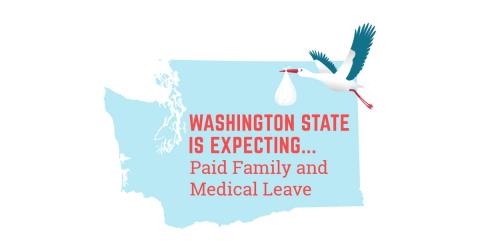
[Graphic of WA State with a stork carrying a bundle and text that says: "Washington State is Expecting...Paid Family and Medical Leave"]
On June 30, 2017, the Washington State Legislature passed SB 5975 with bipartisan support, creating a statewide paid family and medical leave program that will boost moms, families, and our economy.
This bipartisan victory was an incredible testament to what can happen when people come together to find common ground. It was also a testament to the power of movement building by labor, workers rights organizations, and others.
So just what can you expect as Washington State sets up its first-ever paid family and medical leave program? Here’s a quick primer on what to expect when you’re expecting...paid family and medical leave.
Paid Family and Medical Leave Frequently Asked Questions
This list will be updated as we receive new questions from MomsRising members. Do you have a question? Ask it below in the comments!
What is paid family and medical leave? And how is that different from sick leave?
Paid family and medical leave is paid leave from work for the birth, adoption, or foster placement of a child, to help care for a seriously ill family member (including parents, grandparents, grandchildren, siblings, adult children, or for a child you are standing in loco parentis for), or to care for yourself as you recover from a serious medical condition such as surgery or chemotherapy.
Paid sick days are for when you need to miss just a few days of work to recover from a temporary illness, like the flu, or go to the doctor for a regular wellness check up. (And remember, Washington State’s paid sick days law also provides for paid safe leave for all employees in Washington State who need to get help or help a family member with domestic violence, sexual assault or stalking.)
When does paid family and medical leave start? How will it be funded?
The paid family and medical leave program will be paid for through a statewide insurance pool that employees and employers will contribute to beginning January 1, 2019. The program will be administered by the Employment Security Department (ESD).
The average worker will contribute just over $2 per week from their paycheck. Business owners with fewer than 50 employees will have the option of contributing to the insurance pool or not, but their employees will receive benefits regardless. Business owners with fewer than 150 employees that choose to contribute can receive small business assistance.
Some larger employers will cover their employees with voluntary plans, or internal plans that are the same or better than the state program. These plans must be approved by ESD.
Employees can start taking paid family and medical leave on January 1, 2020.
How will I apply for and receive benefits?
When you go to take leave, you will apply for your paid leave benefit through the Employment Security Department. While you are on leave, you will receive your paycheck from ESD rather than your employer (unless you are covered by a Voluntary Plan through your employer, see above). You will be able to apply for family or medical leave online or with a paper application.
Who qualifies for paid family and medical leave?
Anyone who has worked at least 820 hours with one or multiple employers in the past year, including public and part-time employees, can receive paid family and medical leave. Self-employed individuals can opt into the program, but they must remain enrolled for three years.
How long is paid family and medical leave?
Because of a new state program, each year, workers will be able to take:
- 12 weeks of paid family leave to bond with a new child after birth, adoption, or foster placement or to care for a seriously sick spouse, child (including adult children), sibling, grandchild, or grandparent
- 12 weeks of paid medical leave to recover from your own serious medical condition (examples include surgery or a major car accident. Leave cannot be taken for a cold or minor illness)
- OR up to 16 weeks of combined paid family and medical leave (for example, a birth parent could combine a portion of medical and family leave after the birth of a child). *Birth parents who experience pregnancy complications that interfere with their ability to work (as defined by a doctor) can take 2 extra weeks for a total 18 weeks of leave maximum per year.
How much is the paid family leave benefit?
Employees will receive a progressive wage benefit, with low-income workers receiving 90% of their regular wages and higher income workers receiving a lower percentage. The maximum weekly benefit is $1,000.
Is my job protected while I am on leave?
If you are covered by existing FMLA requirements, the leave is job protected. To quality for job protection under FMLA you must work at a company with 50 or more employees, have worked at the company for 1 year, and have worked at least 1,250 hours in the previous year.
Washington’s paid family and medical leave program is a MOMumental step forward for Washington families, communities, and our economy. But now MomsRising needs your help to shout the good news far and wide, especially in your local community with friends, family, and neighbors so more people can benefit from this new program!
Sign up to join our Washington State MomsForce for paid family and medical leave. You'll get the latest and greatest information on the program and receive tools to take action in your community.

![Weekly Premiums chart [Chart of weekly premiums]](https://www.momsrising.org/sites/default/files/styles/retina_quality/public/Screenshot%202018-08-06%2015.57.10_0.png?itok=hmrqhXqA)

The views and opinions expressed in this post are those of the author(s) and do not necessarily reflect those of MomsRising.org.
MomsRising.org strongly encourages our readers to post comments in response to blog posts. We value diversity of opinions and perspectives. Our goals for this space are to be educational, thought-provoking, and respectful. So we actively moderate comments and we reserve the right to edit or remove comments that undermine these goals. Thanks!